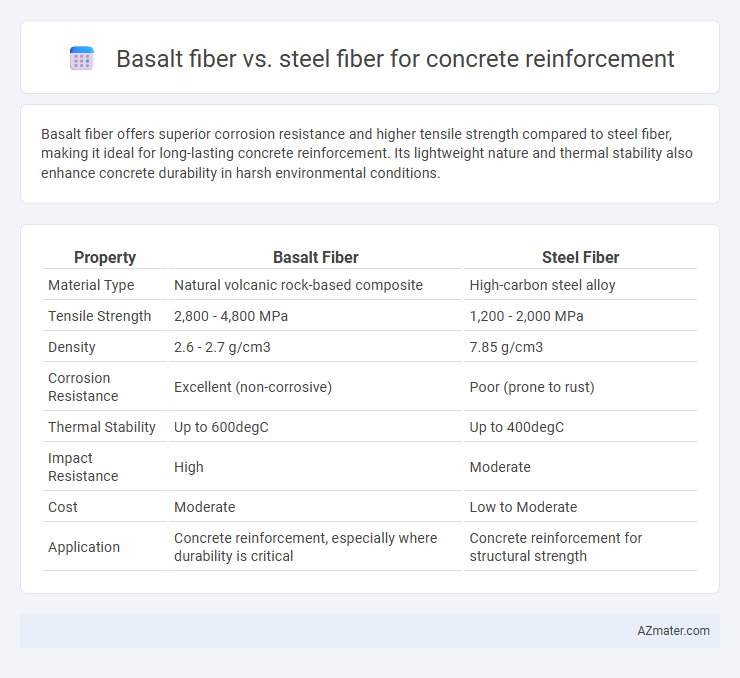Basalt fiber offers superior corrosion resistance and higher tensile strength compared to steel fiber, making it ideal for long-lasting concrete reinforcement. Its lightweight nature and thermal stability also enhance concrete durability in harsh environmental conditions.
Table of Comparison
| Property | Basalt Fiber | Steel Fiber |
|---|---|---|
| Material Type | Natural volcanic rock-based composite | High-carbon steel alloy |
| Tensile Strength | 2,800 - 4,800 MPa | 1,200 - 2,000 MPa |
| Density | 2.6 - 2.7 g/cm3 | 7.85 g/cm3 |
| Corrosion Resistance | Excellent (non-corrosive) | Poor (prone to rust) |
| Thermal Stability | Up to 600degC | Up to 400degC |
| Impact Resistance | High | Moderate |
| Cost | Moderate | Low to Moderate |
| Application | Concrete reinforcement, especially where durability is critical | Concrete reinforcement for structural strength |
Introduction to Fiber Reinforcement in Concrete
Fiber reinforcement enhances concrete performance by improving tensile strength and crack resistance. Basalt fibers offer corrosion resistance and lightweight properties, making them suitable for durability-focused applications. Steel fibers provide high strength and impact resistance, commonly used to boost structural load capacity in concrete.
What is Basalt Fiber?
Basalt fiber is a natural mineral fiber made from volcanic basalt rock, known for its high tensile strength, corrosion resistance, and lightweight properties. Compared to steel fiber, basalt fiber offers superior resistance to chemical and environmental degradation, making it ideal for concrete reinforcement in harsh conditions. Its thermal stability and non-corrosive nature enhance concrete durability, reducing maintenance costs over time.
What is Steel Fiber?
Steel fiber is a high-strength reinforcement material composed of small, discrete steel strands or wires embedded within concrete to improve its tensile strength, toughness, and crack resistance. It enhances structural performance by distributing loads more evenly and reducing the formation of microcracks that can lead to failure. Compared to basalt fiber, steel fiber offers superior ductility and impact resistance but is prone to corrosion if not properly protected in concrete environments.
Physical and Mechanical Properties Comparison
Basalt fiber exhibits a higher tensile strength of approximately 2000-3000 MPa compared to steel fiber's typical range of 1150-1900 MPa, enhancing crack resistance in concrete reinforcement. Basalt fibers have a lower density (~2.6-2.7 g/cm3) than steel fibers (~7.8 g/cm3), contributing to lighter but strong composite materials. The modulus of elasticity for basalt fiber (about 85-95 GPa) is lower than steel fiber's (around 200 GPa), indicating different stiffness characteristics that influence structural performance in reinforced concrete applications.
Durability and Corrosion Resistance
Basalt fiber offers superior durability and corrosion resistance compared to steel fiber, making it ideal for reinforcing concrete in harsh environments. Unlike steel fibers, basalt fibers do not rust or degrade when exposed to moisture, chemicals, or saltwater, significantly extending the lifespan of concrete structures. This enhanced resistance reduces maintenance costs and improves long-term structural integrity in applications such as marine, bridge, and industrial constructions.
Environmental Impact and Sustainability
Basalt fiber offers a significantly lower environmental impact compared to steel fiber, as it is derived from abundant natural volcanic rock with minimal energy-intensive processing. Its production emits fewer greenhouse gases and contributes to reduced carbon footprints in concrete reinforcement. The durability and corrosion resistance of basalt fiber extend the lifespan of concrete structures, enhancing sustainability by reducing maintenance and replacement frequency.
Cost Analysis: Basalt Fiber vs Steel Fiber
Basalt fiber offers significant cost advantages over steel fiber for concrete reinforcement due to its lower raw material and production expenses, resulting in reduced overall project costs. Steel fiber, while providing superior tensile strength, incurs higher costs related to manufacturing, transportation, and corrosion protection, which increase maintenance expenditures. Evaluating lifecycle costs, basalt fiber's resistance to corrosion and chemical degradation enhances durability and minimizes repair frequencies, making it a more economical choice for long-term concrete reinforcement solutions.
Workability and Mixing Behavior
Basalt fiber offers superior workability compared to steel fiber due to its lighter weight and uniform distribution, which reduces fiber balling and improves concrete flow. Steel fiber tends to cause agglomeration during mixing, leading to reduced workability and potential challenges in achieving a homogeneous mix. The enhanced dispersion of basalt fibers enables better mixing behavior, facilitating easier placement and finishing of reinforced concrete.
Performance in Structural Applications
Basalt fiber offers superior corrosion resistance and higher tensile strength compared to steel fiber, enhancing the durability and longevity of concrete structures in harsh environments. Its lightweight nature reduces structural dead load, improving seismic performance and energy absorption capacity in reinforced concrete elements. Steel fiber, while providing excellent ductility and impact resistance, may suffer from corrosion over time, potentially compromising structural integrity without proper protective measures.
Conclusion: Choosing the Right Fiber for Concrete
Basalt fiber offers superior corrosion resistance and lightweight properties, making it ideal for environments prone to chemical exposure and where weight reduction is critical. Steel fiber provides higher tensile strength and impact resistance, which benefits applications requiring enhanced structural durability. Selecting the appropriate fiber depends on project-specific factors such as environmental conditions, mechanical requirements, and cost considerations.

Infographic: Basalt fiber vs Steel fiber for concrete reinforcement
 azmater.com
azmater.com